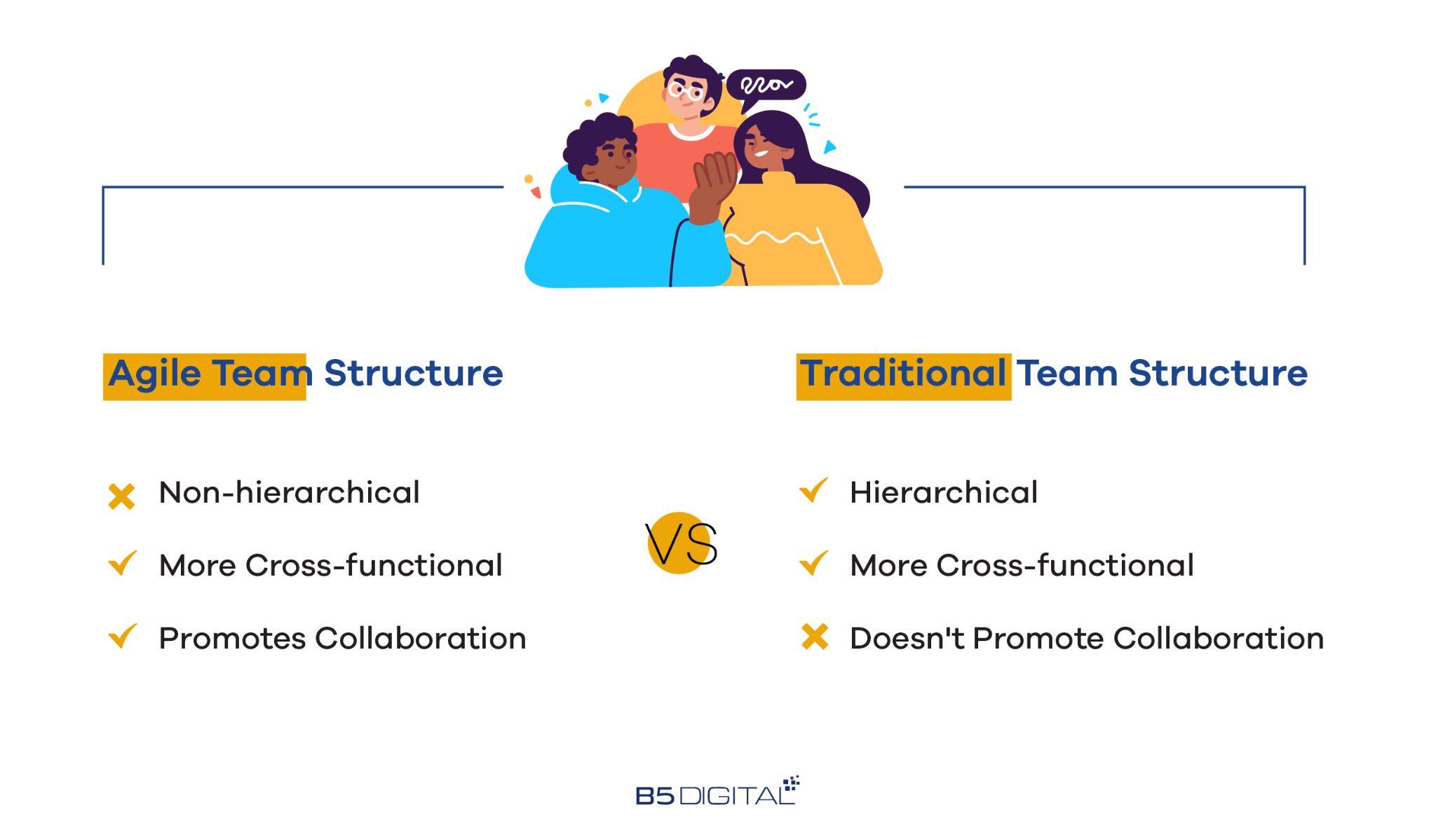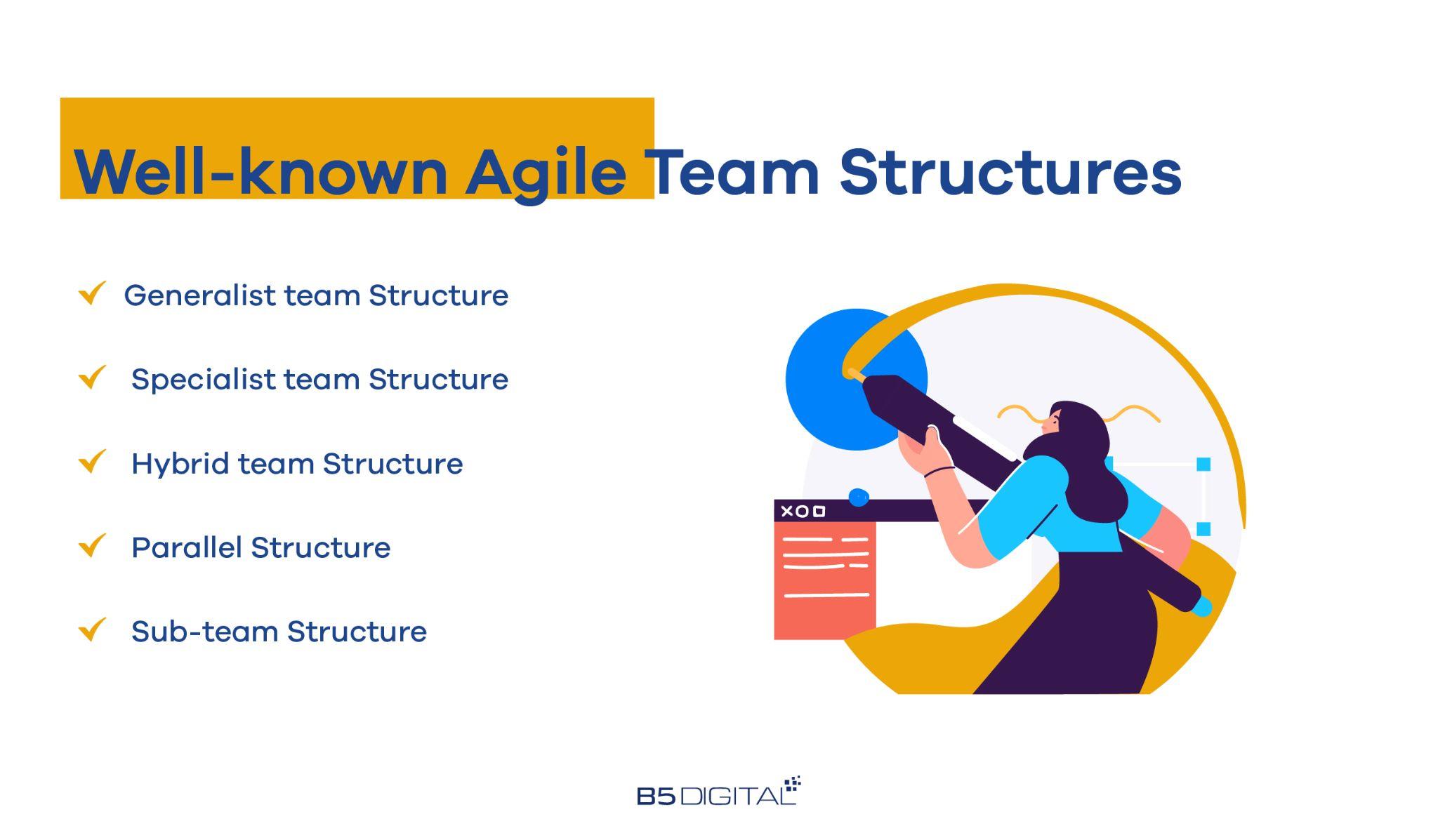Among many factors that can contribute to the success or failure of a software development project, the development team can be the most important one. A great team can overcome any challenges to build a great product.

The way this team works relies heavily on the software development team structure. In this blog, we are sharing how this structure should shape up and what difference it makes.
Why it is Important to Focus on Team Structure
People are key to the success of any product, a digital or a physical one. Not utilizing the full power and creativity of people can be the biggest missed opportunity for many businesses.
Removing one specialization from a software development team can feel like a right decision, and can give no tangible consequence in the short term. However, being reflected on the user experience, for example, it can have big negative consequences that are not considered.
That is why specializations are very important in every software development team, and is a critical part of a healthy structure.
Traditional vs. Agile Team Structure
In addition to structuring a team based on a generalist, specialist or hybrid approach; a team can also have a traditional or agile structure. The core difference between both is that the agile team structure lacks the hierarchy of a traditional team structure. Considering how beneficial an agile structure can be, we will be focusing on it.

How the Agile Team Structure Stands Out
An agile team has different characteristics that make it different from the traditional one, and each comes with a range of benefits that make it stand out.
Non-hierarchy: Classical layers of management are entirely removed inside an agile team. Each member of the team has clear and pre-defined responsibilities, so they don’t need to be directly managed. That doesn’t mean that there is no coordination, as roles like a Scrum Master are focused on coordination. But even the Scrum Master is not a direct manager for the Scrum team.
The non-hierarchical structure of an agile team helps the team work as one towards their goal, as they all focus on a sprint, then another, until the project is successfully completed.
Cross-functionality: Agile development focuses on cross-functionality, as each team member has a specific set of skills that are utilized through the journey of building the product. Cross-functionality means that dependencies are minimized and duties are clear, which helps in removing bottlenecks.
Collaboration: Agile development promotes effective collaboration and communication. The agile team is always working to share knowledge when needed, and this is supported by the team being all focused on the small phase of the project they are working on (the sprint).

Agile Team Structures
First off, there are different types of known structures for a software development team. The generalist, specialist and hybrid structures are different in many ways. For each of them, there are projects that can fit. This is how each of the software development team structures works.

Generalist team structure
A generalist team structure relies on a group of professionals who are all skilled and experienced in many product fields each, with no deep expertise in a specific branch for any of them.
This can lead to great knowledge for every member of the team about the product, and facilitate communication in many ways. However, this team structure can lead to a big challenge of not having a team member who is very deeply experienced with a particular niche.
Specialist team structure
For the specialist team structure, every team member is experienced in a specific niche. But has general knowledge on the other ones. In such a team, everyone is always doing a particular job that is often in the same niche or technology.
Such a team can help the product deliver better quality compared to the generalist structure if communication barriers between the team who are each experienced in something different are removed.
The gaps in communication can be closed by using agile methodologies, where the project is broken into smaller phases called sprints. Using project management and communication tools can also help make this team structure work.
Hybrid team structure
The hybrid team structure is a combination of both generalist and specialist team structures. A team that is structured this way can work through a generalistic structure, yet the team tends to have specializations like in the specialist team structure when needed.
As a combination of the two available choices, many startups utilize this team structure. That doesn’t mean that it has no downsides. Hybrid specialists, as described, can at some point disagree on a certain issue. But using agile and effective project management can help overcome such challenges.
Parallel structure
In a parallel team structure, the development team members change tasks with iterations. This means that a developer can code in one sprint and test in another. The biggest downside of this structure is that it requires extensive training or can lead to inefficiency.
Sub-team structure
The sub-team structure relies on the team being divided into smaller teams, and it works for relatively larger agile teams. An agile team in the Scrum framework usually has 3-9 members, so for larger teams, this structure can be necessary.
When large teams are divided into smaller ones, many challenges can be overcome and benefits can be realized, including enhanced accountability, visibility, communication, coordination, and more.
How to choose the right development team structure?
Choosing a structure that fits your software development project is a critical decision. Here is what to consider when choosing the right structure for your team.
Project complexity
The complexity level of your project can have a specific need when it comes to your team structure. If you are building a large platform with multiple features. A specialist structure would work better, as the project involves multiple technologies and specializations. However, if you are building a platform in a very niche domain, a small generalist team would work.
This clearly means that the nature of the project can directly impact the benefits and downsides of each team structure that can be followed.
Coordination ability
One of the biggest issues that can arise with specialist teams is that they can suffer from ineffective communication and continuous conflicts. This requires coordination. If you can coordinate yourself or hire a product manager or Scrum Master for coordination. Then the specialist team structure can suit you better.
The coordinator needs to have general knowledge of the different niches included in the project. While having the ability to quickly transform team communication to become effective.
Project budget
The budget of the project is one important factor that can help you decide on the chosen structure for the team. The budget determines how big your team is, and can become. Also if you can hire senior roles like a product owner or product manager or not.

Our best practices for structuring an agile team
As a software development company, we ensure at B5 Digital that the structure of our growing team (from 9 to 20 members in the last 18 months) is bringing clients the highest possible value with a top-notch product quality, at a quite competitive cost that is driven by efficiency. This is what we focus on as we build and grow our team:
- Answering client needs: As a company that mostly partners with businesses to build their software products, we consistently ensure that the team structure serves the needs of each client, and this determines which new talents should be hired, their expertise, and whether our Scrum team needs another sub-team.
- Using the Scrum framework: Our chosen framework for agile software development is the Scrum framework, meaning that our team has: developers, , designers, testers, and product owners, in addition to a tech lead and a scrum master.
- Hiring the best talents: Our most valuable resource is our people, and this is the case with your company as well. This is why we ensure that we are hiring top talents.
Final Thoughts
An appropriate team structure is important for the success of a software project. The agile structure is clearly favorable over the traditional structure. But even for an agile team, there are different structures to choose from, and you need to carefully decide.





